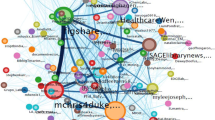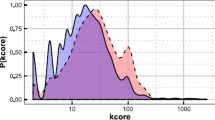Abstract
Papers published in top conferences or journals is an important measure of the innovation ability of institutions, and ranking paper acceptance rate can be helpful for evaluating affiliation potential in academic research. Most studies only focus on the paper quality itself, and apply simple statistical data to estimate the contribution of institutions. In this work, a novel method is proposed by combining different types of features of affiliation and author to predict the paper acceptance at the institutional level. Based on the history of the paper published, this work firstly calculates the affiliation scores, constructs an institutional collaboration network and analyzes the importance of the institutions using network centrality measures. Four measures about the authors’ influence and capability are then extracted to take the contributions of authors into consideration. Finally, a random forest algorithm is adopted to solve the prediction problem of paper acceptance. As a result, this paper improves the ranking of the paper acceptance rate NDCG@20 to 0.865, which is superior to other state-of-the-art approaches. The experimental results show the effectiveness of proposed method, and the information between different types of features can be complementary for predicting paper acceptance rate.








Similar content being viewed by others
References
Al-Juboori, A. F. M. A., Su, D. J., & Ko, F 2011 University Ranking and Evaluation: Trend and Existing Approaches. In The International Conference on Next Generation Information Technology 137–142
Bai, X., Zhang, F., Hou, J., Xia, F., Tolba, A., & Elashkar, E. (2017). Implicit multi-feature learning for dynamic time series prediction of the impact of institutions. IEEE Access, 99, 1–1.
Barabási, A. L., Jeong, H., Néda, Z., Ravasz, E., Schubert, A., & Vicsek, T. (2002). Evolution of the social network of scientific collaborations. Physica A: Statistical Mechanics and its Applications, 311(3), 590–614.
Belgiu, M., & Drăguţ, L. (2016). Random forest in remote sensing: A review of applications and future directions. Isprs Journal of Photogrammetry & Remote Sensing, 114, 24–31.
Bellingeri, M., Bevacqua, D., Scotognella, F., & Cassi, D. (2019). The heterogeneity in link weights may decrease the robustness of real-world complex weighted networks. Scientific Reports. https://doi.org/10.1038/s41598-019-47119-2.
Clemente, G. P., & Cornaro, A. (2019). A novel measure of edge and vertex centrality for assessing robustness in complex networks. Soft Computing. https://doi.org/10.1007/s00500-019-04470-w.
Crucitti, P., Latora, V., Marchiori, M., & Rapisarda, A. (2000). Error and attack tolerance of complex networks. Nature, 340(1), 378–382.
Cuthbert, R. (2011). University rankings, diversity, and the new landscape of higher education. International Journal of Lifelong Education, 30(1), 119–121.
Désir, C., Bernard, S., Petitjean, C., & Heutte, L. (2013). One class random forests. Pattern Recognition, 46(12), 3490–3506.
Gao, M., Xu, L., Lin, L. M., Huang, Y. Z., & Zhang, X. X. (2020). Influence maximization based on activity degree in mobile social networks. Concurrency and Computation-Practice & Experience. https://doi.org/10.1002/cpe.5677.
Gupta, A., & Murty, M. N. (2016). Finding Influential Institutions in Bibliographic Information Networks.
Hao, Y. C., Jia, L. M., & Wang, Y. H. (2020). Edge attack strategies in interdependent scale-free networks. Physica a-Statistical Mechanics and Its Applications. https://doi.org/10.1016/j.physa.2019.122759.
Holme, P., Edling, C. R., & Liljeros, F. (2004). Structure and time evolution of an Internet dating community. Social Networks, 26(2), 155–174.
Klimek, P., Jovanovic, S. A., Egloff, R., & Schneider, R. (2016). Successful fish go with the flow: citation impact prediction based on centrality measures for term–document networks. Scientometrics, 107(3), 1265–1282. https://doi.org/10.1007/s11192-016-1926-1.
Lordan, O., & Sallan, J. M. (2019). Core and critical cities of global region airport networks. Physica a-Statistical Mechanics and Its Applications, 513, 724–733. https://doi.org/10.1016/j.physa.2018.08.123.
Mussard, M., & James, A. P. (2018). Engineering the global university rankings: Gold standards, its limitations and implications. IEEE Access, 99, 1–1.
Orouskhani, Y., & Tavabi, L. (2016). Ranking Research Institutions Based On Related Academic Conferences. arXiv e-prints,
Pedregosa, F., Varoquaux, G., Gramfort, A., Michel, V., Thirion, B., Grisel, O., et al. (2012). Scikit-learn: Machine Learning in Python.
Qian, Y., Dong, Y., Ma, Y., Jin, H., & Li, J. (2016). Feature Engineering and Ensemble Modeling for Paper Acceptance Rank Prediction.
Qiu, Z., Kong, D., Zhu, Z., Lu, H., & Cheng, J. (2016). Heterogenous Graph Mining for Measuring the Impact of Research Institutions.
Ren, X., & Lü, L. (2014). Review of ranking nodes in complex networks. Chinese Science Bulletin, 59(13), 1175.
Rintyarna, B. S., Sarno, R., & Yuananda, A. L. Automatic ranking system of university based on technology readiness level using LDA-Adaboost.MH. In International Conference on Information and Communications Technology, 2018 495–499
Safaei, F., Yeganloo, H., & Akbar, R. (2020). Robustness on topology reconfiguration of complex networks: An entropic approach. Mathematics and Computers in Simulation, 170, 379–409. https://doi.org/10.1016/j.matcom.2019.11.013.
Sandulescu, V., & Chiru, M. (2016). Predicting the future relevance of research institutions - The winning solution of the KDD Cup 2016.
Shen, D. Q., & Cao, S. S. (2018). An efficient immunization strategy based on transmission limit in weighted complex networks. Chaos Solitons & Fractals, 114, 1–7. https://doi.org/10.1016/j.chaos.2018.06.014.
Sinha, A., Shen, Z., Song, Y., Ma, H., Eide, D., Hsu, B. J., et al. An Overview of Microsoft Academic Service (MAS) and Applications. In International Conference on World Wide Web, 2015 (pp. 243–246)
Szentirmai, L., & Radacs, L. World university rankings qualify teaching and primarily research. In IEEE International Conference on Emerging Elearning Technologies and Applications, 2013 (pp. 369–374)
Tran, V. H., Cheong, S. A., & Bui, N. D. (2019). Complex network analysis of the robustness of the hanoi, vietnam bus network. Journal of Systems Science and Complexity, 32(5), 1251–1263. https://doi.org/10.1007/s11424-019-7431-x.
Wang, Y., Wang, L., Li, Y., He, D., Liu, T. Y., & Chen, W. (2013). A theoretical analysis of ndcg type ranking measures. Journal of Machine Learning Research, 30, 25–54.
Wilson, J., Mohan, R., Arif, M., Chaudhury, S., & Lall, B. (2016). Ranking academic institutions on potential paper acceptance in upcoming conferences.
Xie, J. (2016). Predicting Institution-Level Paper Acceptance at Conferences: A Time-Series Regression Approach.
Zhang, J., Xu, B., Liu, J., Tolba, A., Al-Makhadmeh, Z., & Xia, F. (2018). PePSI: Personalized Prediction of Scholars’ Impact in Heterogeneous Temporal Academic Networks.
Zhang, X. J., Tang, Y., Xiong, J. S., Wang, W. J., & Zhang, Y. C. (2020). Ranking game on networks: The evolution of hierarchical society. Physica a-Statistical Mechanics and Its Applications. https://doi.org/10.1016/j.physa.2019.123140.
Acknowledgements
This work is supported by the National Natural Science Foundation of China (Nos. 61472282, and 61672035) and Anhui Provincial Department of Education (No. KJ2019ZD05), Open Fund from Key Laboratory of Metallurgical Emission Reduction & Resources Recycling (No. KF 2017-02), the fund of Co-Innovation Center for Information Supply & Assurance Technology in AHU (No. ADXXBZ201705), and Anhui Scientific Research Foundation for Returned Scholars.
Author information
Authors and Affiliations
Corresponding authors
Rights and permissions
About this article
Cite this article
Wang, W., Zhang, J., Zhou, F. et al. Paper acceptance prediction at the institutional level based on the combination of individual and network features. Scientometrics 126, 1581–1597 (2021). https://doi.org/10.1007/s11192-020-03813-x
Received:
Published:
Issue Date:
DOI: https://doi.org/10.1007/s11192-020-03813-x




